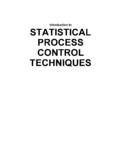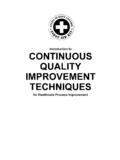Transcription of Introduction to STATISTICAL PROCESS CONTROL …
1 Introduction to STATISTICAL PROCESS CONTROL TECHNIQUES SPC OVERVIEW iii Preface 1 Quality CONTROL Today 1 New Demands On Systems Require Action 1 Socratic SPC -- Overview Q&A 2 Steps Involved In Using STATISTICAL PROCESS CONTROL 6 Specific SPC Tools And Procedures 7 Identification and Data gathering 7 Prioritizing 7 Pareto Charts 7 Analysis Of Selected Problem 9 Cause-and-Effect or Fishbone Diagram 9 Flowcharting 10 Scatter Plots 11 Data Gathering And Initial Charting 12 Check Sheets 12 Histograms 12 Probability Plot 13 CONTROL Charts 14 Fundamental Concepts And Key Terms 14 Rules Testing 15 Zones In CONTROL Charts 15 CONTROL Limits 16 Subgroups 17 Phases 17 Using PROCESS CONTROL Charts 18 Data Definitions For Proper Chart Selection 18 2007 Statit Software, Inc.
2 , 1128 NE 2nd Street, Ste 108, Corvallis, Oregon 97330 SPC OVERVIEW iv Types Of Charts Available For The Data Gathered 20 Variable Data Charts Individual, Average And Range Charts 20 Individual Charts I chart 20 Average Charts X-bar Chart 21 Range Chart R-Chart 22 Moving Range Chart MR Chart 23 Combination Charts 24 Individual And Range Charts IR Charts 24 Average & Range Charts X-Bar And R Charts 25 X-Bar Standard Deviation Charts X-Bar And S Charts 26 PROCESS Capability Chart cp Chart 27 Attribute Data Charts 28 Attribute Charts Defects and Rejects Charts 29 Defects Charts 29 c Chart Constant Subgroup Size 29 u Chart Varying Subgroup Size 30 Rejects Charts 31 np Chart Number of Rejects Chart for Constant Subgroup Size 31 p Chart Percentage Chart for Varying
3 Subgroup Size 32 Conclusion Time to put it all 33 Appendix 1: AT&T s STATISTICAL Quality CONTROL Standards 34 Glossary 36 Bibliography 41 URLs 41 Preface: by Marilyn K. Hart, & Robert F. Hart, Quality CONTROL Today In this era of strains on the resources and rising costs of manufacturing, it becomes increasingly apparent that decisions must be made on facts, not just opinions. Consequently, data must be gathered and analyzed. This is where STATISTICAL PROCESS CONTROL (SPC) comes in. For over 70 years, the manufacturing arena has benefited from the tools of SPC that have helped guide the decision-making PROCESS .
4 In particular, the CONTROL chart has helped determine whether special-cause variation is present implying that action needs to be taken to either eliminate that cause if it has a detrimental effect on the PROCESS or to make it standard operating procedure if that cause has a beneficial effect on the PROCESS . If no special-cause variation is found to be present, SPC helps define the capability of the stable PROCESS to judge whether it is operating at an acceptable level. The strength of SPC is its simplicity. And with the use Statit on the computer to make the calculations and to plot the charts, the simplicity becomes complete. New Demands On Systems Require Action Accountability with hard data, not fuzzy opinions, is being demanded.
5 Existing processes must be examined and new ones discovered. The good news is that improved quality inherently lowers costs as it provides a better product and/or service. STATISTICAL PROCESS CONTROL provides accountability and is an essential ingredient in this quality effort. STATISTICAL PROCESS CONTROL is not an abstract theoretical exercise for mathematicians. It is a hands-on endeavor by people who care about their work and strive to improve themselves and their productivity every day. SPC charts are a tool to assist in the management of this endeavor. The decisions about what needs to be improved, the possible methods to improve it, and the steps to take after getting results from the charts are all made by humans and based on wisdom and experience.
6 Everyone should be involved in this effort! SPC OVERVIEW 2 Socratic SPC -- Overview Q&A So what is STATISTICAL PROCESS CONTROL ? STATISTICAL PROCESS CONTROL is an analytical decision making tool which allows you to see when a PROCESS is working correctly and when it is not. Variation is present in any PROCESS , deciding when the variation is natural and when it needs correction is the key to quality CONTROL . Where did this idea originate? The foundation for STATISTICAL PROCESS CONTROL was laid by Dr. Walter Shewart working in the Bell Telephone Laboratories in the 1920s conducting research on methods to improve quality and lower costs. He developed the concept of CONTROL with regard to variation, and came up with STATISTICAL PROCESS CONTROL Charts which provide a simple way to determine if the PROCESS is in CONTROL or not.
7 Dr. W. Edwards Deming built upon Shewart s work and took the concepts to Japan following WWII. There, Japanese industry adopted the concepts whole-heartedly. The resulting high quality of Japanese products is world-renowned. Dr. Deming is famous throughout Japan as a "God of quality". Today, SPC is used in manufacturing facilities around the world. What exactly are PROCESS CONTROL charts? CONTROL charts show the variation in a measurement during the time period that the PROCESS is observed. In contrast, bell-curve type charts, such as histograms or PROCESS capability charts, show a summary or snapshot of the results. PROCESS CONTROL charts are fairly simple-looking connected-point charts.
8 The points are plotted on an x/y axis with the x-axis usually representing time. The plotted points are usually averages of subgroups or ranges of variation between subgroups, and they can also be individual measurements. Some additional horizontal lines representing the average measurement and CONTROL limits are drawn across the chart. Notes about the data points and any limit violations can also be displayed on the chart. SPC OVERVIEW 3 What is the purpose of CONTROL charts? CONTROL charts are an essential tool of continuous quality CONTROL . CONTROL charts monitor processes to show how the PROCESS is performing and how the PROCESS and capabilities are affected by changes to the PROCESS .
9 This information is then used to make quality improvements. CONTROL charts are also used to determine the capability of the PROCESS . They can help identify special or assignable causes for factors that impede peak performance. How do they work? CONTROL charts show if a PROCESS is in CONTROL or out of CONTROL . They show the variance of the output of a PROCESS over time, such as a measurement of width, length or temperature. CONTROL charts compare this variance against upper and lower limits to see if it fits within the expected, specific, predictable and normal variation levels. If so, the PROCESS is considered in CONTROL and the variance between measurements is considered normal random variation that is inherent in the PROCESS .
10 If, however, the variance falls outside the limits, or has a run of non-natural points, the PROCESS is considered out of CONTROL . What s this relationship between variation and assignable causes? Variation is the key to STATISTICAL PROCESS CONTROL charts. The extent of variation in a PROCESS indicates whether a PROCESS is working as it should. When the variation between the points is large enough for the PROCESS to be out of CONTROL , the variation is determined to be due to non-natural or assignable (special) causes. So how are these normal-predictable variance levels determined? One of the beauties of CONTROL charts is that the PROCESS itself determines the CONTROL limits.





